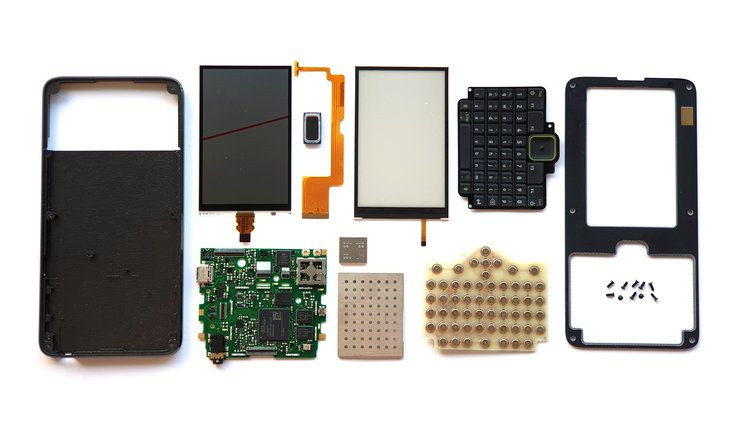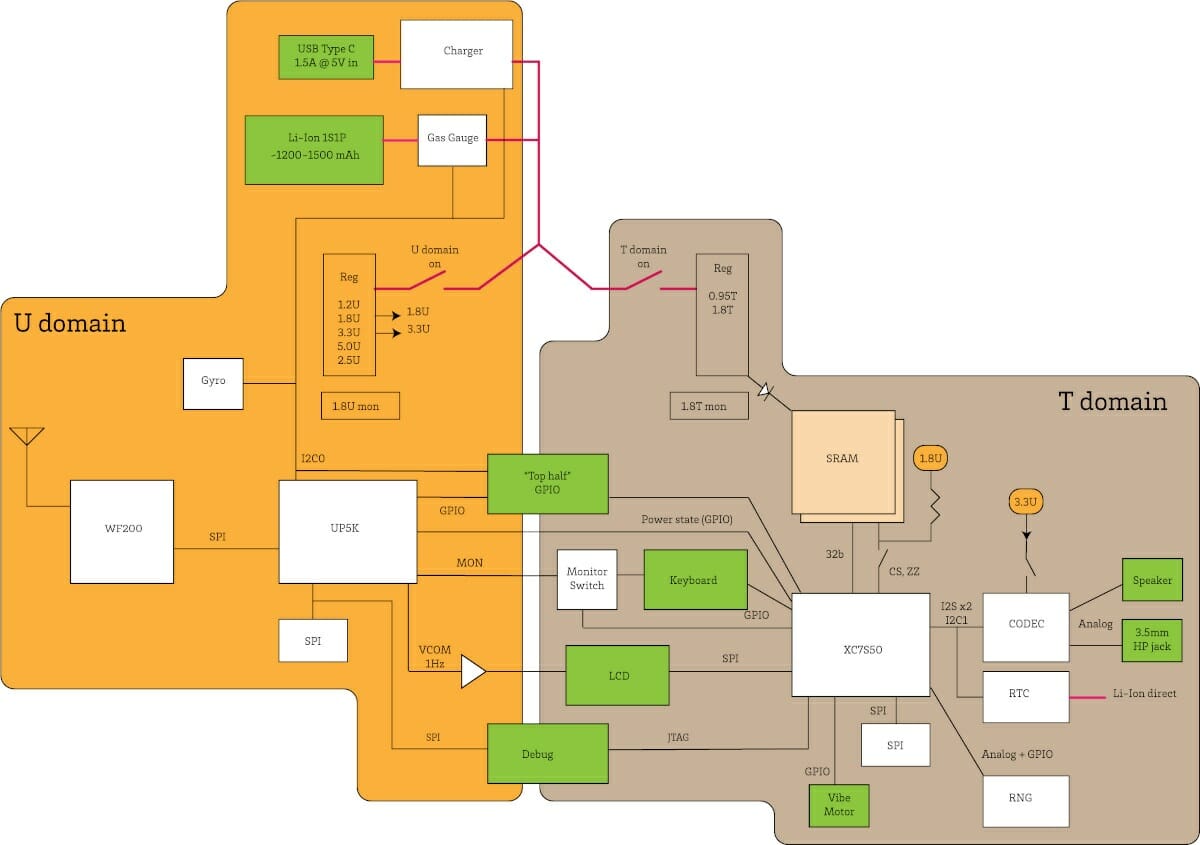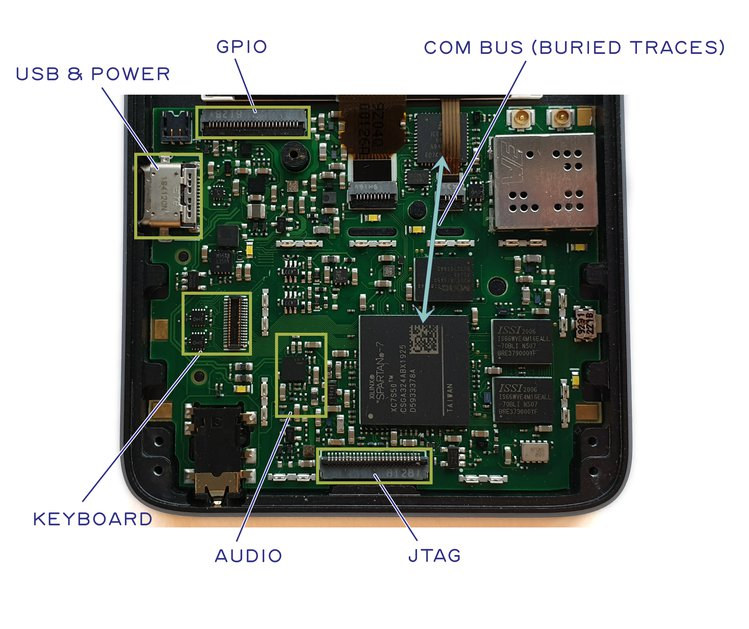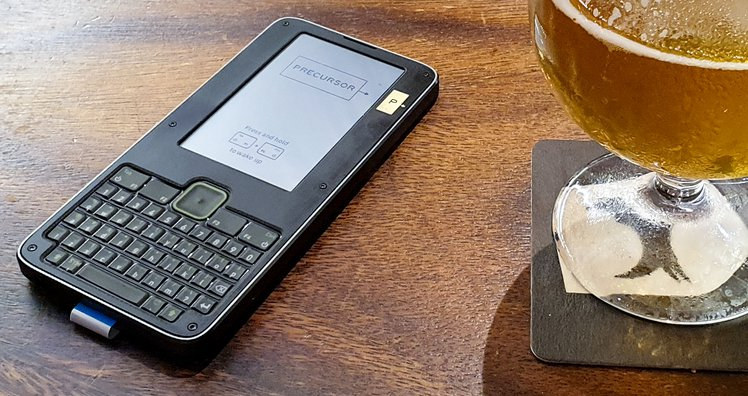Sutajio Ko-usagi PTE LTD has launched some interesting hardware on Crowd Supply over the years include Novena open-source hardware Arm laptop, and Fomu FPGA USB board.
The company is now back with another project: Precursor, a mobile, open-source hardware devkit powered by not one, but two FPGA with Xilinx Spartan 7-Series FPGA, plus a super-low-power Lattice iCE40 UP5K FPGA for deep-sleep system management. The device also comes with a display, battery, and keyboard that make it looks like older Palm or Blackberry phones.
Precursor FPGA devkit specifications:
- FPGA
- Xilinx XC7S50 primary System on Chip (SoC) FPGA with -L1 speed grade for longer battery life; tested with 100 MHz VexRISC-V, RV32IMAC + MMU, 4k L1 I/D cache
- Lattice Semi iCE40UP5K secondary Embedded Controller (EC) FPGA for power, standby, and charging functions; tested with 18 MHz VexRISC-V, RV32I, no cache
- System Memory – 16MB external SRAM
- Storage – 128MB flash
- Display -536 x 336 black & white LCD with 200ppi, backlight
- Audio – 0.7 W speaker for notifications, vibration motor, 3.5 mm headset jack, no integrated microphone
- Connectivity – 802.11 b/g/n WiFi via sandboxed Silicon Labs WF200C chipset for longer battery life
- USB – 1x USB 2.0 Type-C port for data and charing
- User Input – Physical backlit keyboard with changeable layout overlays (QWERTZ, AZERTY, and Dvorak)
- Sensor – Accelerometer and gyroscope
- Expansion – Flex PCB breakout for 8x FPGA GPIO into the battery compartment
- Debugging
- Custom Raspberry Pi HAT and developer’s cable for GDB + Chipscope and firmware flashing
- USB cable via wishbone tunnel for middleware debugging
- Custom Raspberry Pi HAT and developer’s cable for GDB + Chipscope and firmware flashing
- Security
- Dual hardware TRNG
- Anti-tamper features
- User-sealable metal can for trusted components
- Dedicated real-time clock (RTC) with basic clock integrity monitoring
- Power monitors trip reset in case of power glitches
- Always-on accelerometer/gyro to detect movement in standby
- Support for instant secure erase via battery-backed AES key and self-destruct circuit
- Battery – Replaceable 1,100 mAh Li-Ion battery good for about 100 hours standby with Wi-Fi + embedded controller + static display enabled, or 5 hours and a half of continuous use.
- Dimensions – 138 x 69 x 7.2 mm (Alloy aluminum case)
- Weight – 96 grams

In theory, you can run anything you’d like on the FPGA core, but as you can see from the specifications, they’ve tested RISC-V soft cores on the chips. You may wonder why a mobile device would not come with a built-in microphone, and a speaker that only good for notifications. That’s because Precursor focuses on security beyond the anti-tempering measures. Since you can only communicate by plugging a headset, it’s impossible to be spied on when the headset is not connected.
The source code, the hardware design files such as schematics and PCB layout, as well as 3D files for the enclosure can all be found on Github, and the company encourages forking the code, as well as submitting pull requests or filling bug reports in the issue tracker.


Precursor FPGA devkit has just launched on Crowd Supply with a fairly high $220,000 funding target in order to fund software development for at least one year. There were 50 early bird units at $450, but now rewards start at $512 for a fully assembled Precursor device, one “debug board” HAT, and four grams of EPO-TEK 301 in a bi-pak, for sealing the metal shield. It should be noted that if you decide to seal the shield, it will be permanent and warranty returns/exchanges are not possible on sealed devices. Shipping is free worldwide, and deliveries are expected to start on December 2, 2021, or over one year from now.

Jean-Luc started CNX Software in 2010 as a part-time endeavor, before quitting his job as a software engineering manager, and starting to write daily news, and reviews full time later in 2011.
Support CNX Software! Donate via cryptocurrencies, become a Patron on Patreon, or purchase goods on Amazon or Aliexpress





